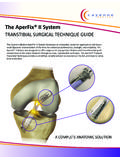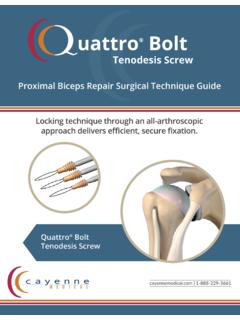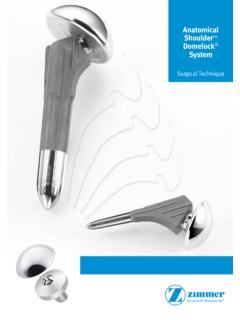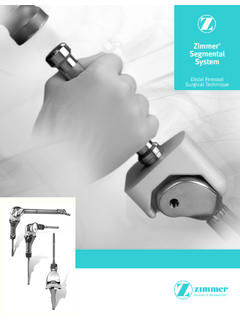Transcription of Partial Knee System - Cayenne Medical
1 Partial knee SystemUnicondylar surgical Technique520-1115-00 Rev MCat. No. 400008 Cayenne Medical , Inc. - A Zimmer Biomet Company16597 North 92nd St, Suite 101 Scottsdale, AZ 2 MIRROR surgical TechniquePage 3 MIRROR surgical TechniqueContentsIndications and Contraindications 4 Introduction 5 Mirror Partial knee System 6 Procedure Overview 7 Initial Incision 8 Tibial Preparation 9 Femoral Preparation 16 Femoral Implant Sizing 25 Drill or Punch Tibial Holes 26 Implant Trials 27 Cement Fixation 28 Lateral Uni Considerations 30 Femoral Component Dimensions 31 Tibial Baseplate Dimensions 32 Poly Component Dimensions 33 Instrument List 34 Implant Part Numbers 35 Page 4 MIRROR surgical TechniqueIndications and ContraindicationsThe Mirror Partial knee System by Cayenne Medical , Inc. is intended for arthroplasty of either the medial or lateral tibiofemoral compartment of the knee with the following indications: Non-inflammatory degenerative joint disease including post-traumatic arthritis and osteoarthritis.
2 Failed previous implant. Correctable deformity. All Mirror Partial knee System implants are intended for cemented use only. Implant components of this System are designed for single use and to be used as a Mirror Partial knee System is contraindicated in: Infection, sepsis, or infections with potential to spread to the implant site. Patients incapable of or unwilling to comply with surgeon instructions, including ability to maintain weight and limit activity. Osteomalacia, insufficient bone stock, excessive bone loss or bone resorption apparent on roentgenogram. Deficient or absent ACL, PCL or collateral ligament; incomplete or deficient soft tissue. Neuropathic joint, vascular insufficiency or muscular atrophy. Skeletal immaturity. Severe varus or valgus deformity. Severe extension or flexion 5 MIRROR surgical TechniqueIntroductionBackgroundLigament guided surgery utilizes the patient s unique knee motion to guide preparation of the femoral condyle in unicompartmental knee arthroplasty ( Partial knee replacement).
3 This surgical technique describes the procedure and instrumentation for implanting the Mirror Partial knee Mirror Partial knee System combines proven implant design features with a straightforward and repeatable surgical technique to enhance implant positioning and soft tissue balancing. The materials used in the Mirror Partial knee System , as well as the articular compliance and bone fixation, are based on review of long-standing unicompartmental implant designs with proven clinical ,2,3,4,5,6,7,8 The Mirror Partial knee System is composed of unicompartmental femoral components and unicompartmental tibial components designed for cement fixation. These components may be used to create a replacement of the medial or lateral tibiofemoral compartment. Mirror Partial knee System components include individually sterile-packaged femoral components made of cobalt-chromium alloy and Modular Tibial Baseplates made of titanium alloy used with ultra-high molecular weight polyethylene Tibial Inserts.
4 The Mirror Partial knee System instrumentation System utilizes cutting elements supported on the resected tibial plateau to prepare the femoral condyle. The tibiofemoral compartment is dynamically distracted during condyle preparation to provide optimal ligament balance throughout range of medial tibiofemoral compartmental arthritis, the compartment is exposed through a medial parapatellar incision and medial arthrotomy. The Mirror Partial knee System , instrumentation and surgical technique can be used for lateral compartment Partial knee replacement; however, the lateral compartment is technically more challenging and should not be attempted until experience has been gained with medial compartment Partial knee Argenson JN, Parratte S, Flecher X, Aubaniac JM, Unicompartmental knee Arthroplasty: technique Through a Mini-incision Clinical Orthopaedics and Related Research 2007; 464 Argenson JN, Komistek RD, Aubaniac JM, Dennis DA, Northcut EJ, Anderson DT, Agostini S. In vivo determination of knee kinematics for subjects implanted with a unicompartmental arthroplasty.
5 J Arthroplasty. 2002;17:1049 Berger RA, Meneghini RM, Jacobs JJ, Sheinkop MB, Della Valle GJ, Rosenberg AG, Galante JO. Results of unicompartmental knee arthroplasty at a minimum of ten years of follow-up. J Bone Joint Surg Am. 2005;87:999 Fuchs S, Rolauffs B, Plaumann T, Tibesku CO, Rosenbaum D., Clinical and functional results after the rehabilitation period in minimally-invasive unicondylar knee arthroplasty patients. knee Surg Sports Traumatol Arthrosc. 2005;13:179 Hollinghurst D, Stoney J, Ward T, et al. No deterioration of kinematics and cruciate function 10 years after medial unicompartmental arthroplasty. knee . 2006;13 Newman J, Pydisetty RV, Ackroyd C. Unicompartmental or total knee replacement: The 15-year results of a prospective randomized controlled trial. J Bone Joint Surg Br. Jan 2009; 91-B;1 McAllister CM. The role of unicompartmental knee arthroplasty versus total knee arthroplasty in providing maximal performance and satisfaction. J knee Surg. 2008;21 Walton NP, Jahromi I, Lewis PL, et al.
6 Patient-perceived outcomes and return to sport and work: TKA versus mini-incision unicompartmental knee arthroplasty. J knee Surg. 2006;19 6 MIRROR surgical TechniqueMirror Partial knee SystemFemoral Component Symmetric: The implants, placed 90 to each other, provide tibiofemoral tracking centralized on the tibial component. The implant has a dual radius design, matching the prepared surface of the femoral condyle. The implants are interchangeable between medial and lateral compartments, and left and right knees. Bone Interface: Sculpted implant support surface without planer resection and two peg holes proved a uniform, congruent cement surface. The pegs provide significant stability for final implantation. The entire bottom surface including pegs are grit blasted to enhance cement fixation. The posterior peg is long enough to aid in placing the component in small spaces for final implantation. Versatility: Mirror uses the ligaments to guide preparation of the femoral condyle, thereby allowing placement of the implants to match the articular surface and create a uniform tibiofemoral gap throughout the entire range of motion.
7 The implants come in 38mm, 42mm, 46mm, 50mm, and 54mm. Sizes 42mm and 46mm are used in the majority of instances. Tibial Component Symmetric: The implants are available in four sizes 44mm, 48mm, 52mm, 56mm and four thicknesses, 8mm, 9mm, 10mm, 11mm. They can be used for both medial and lateral compartments, as well as left and right knees. A left medial baseplate can be used on the right lateral side, and the right medial component can be used on the left lateral tibia. Kinematics: Ligament Guided Surgery uses ACL/PCL to position and orient the femoral component with respect to the tibial component, putting the implants where the patient s own ligaments want them placed, coupling femoral positioning and orientation to the tibial position and orientation. Femoral flexion/extension orientation on the condyle is a function of tibial posterior 1 Figure 2 Figure 3 Page 7 MIRROR surgical TechniqueStep 1: Assemble tibial resection guide and place it on the tibia. Set tibia resection depth, posterior slope, and sagittal alignment.
8 Pin the tower and cutting block. Step 2: Resect the 3: Insert spacer lollipop into flexion/extension space to determine gap 4: Place and impact adjustable guide on tibia, directly underneath center of posterior condyle at 90 .Step 5: Slide and lock the Balancer with shim into the adjustable 6: Place Positioner on top of Balancer with knee in 90 7: Mark blue line on condyle through the Positioner, over center of femoral 8: Advance cutter bit into posterior condyle at 90 over blue line with bit spinning. Flex knee to 120 with cutter spinning, then extend to 180 . STOP CUTTER and remove. Step 9: Transfer shim from Balancer to Planer base, insert and lock into Planer base. Insert Planer base into adjustable guide to locked 10: Resurface femoral condyle using steps 1-6 with cutter inserted into Planer cutter block. Step 11: Size for femoral component and drill peg holes for the 12: Punch or drill peg holes for the tibia 13: Place trials for tibia and femur, confirming 14: Cement tibial baseplate, femoral component and place poly into baseplate.
9 Procedure OverviewStep 1 Step 8 Step 2 Step 9 Step 3 Step 10 Step 4 Step 11 Step 5 Step 12 Step 6 Step 7 Step 13 Step 14 Page 8 MIRROR surgical TechniqueInitial IncisionA medial peripatellar skin incision is made starting approximately 1 cm proximal to the superior border of the patella and extending to the level of the tibial tubercle. Note: A longer incision is advised when first starting to use the procedure or if the patient is obese. After exposing the joint cavity, the extent of arthritic damage and suitability for a Partial knee replacement procedure is assessed. The medial meniscus is excised to provide clear visualization of the joint. As bone resections are made, the remaining medial meniscus should be removed. Sections of the fat pad may also be resected. Marginal osteophytes are removed medially and within the intercondylar notch on the femur, and around the medial tibial plateau. Note: Ligament releases should not be 4 Page 9 MIRROR surgical TechniqueTibial PreparationThe goal for the tibial resection is to place the tibial component at 0 varus slope, that is at 90 to the anatomic axis of the Instrument AssemblyThe body of the Tibial Resection Guide is assembled by sliding the upper and lower portions of the Extramedullary Rod (EM Rod Upper and EM Rod Lower, respectively) together to form a telescoping body.
10 Our EM rods come in short and long sizes. The short rod is typically used with female patients and the long rod is typically used with male patients. Slide the extramedullary (EM) upper rod into the EM lower rod creating the base tower. Tighten knob. Pass the rod end of the ankle clamp through the inferior end of the lower rod. Pass lower tower rod through the posterior slope slider bar, which will be placed and secured anterior to the ankle clamp. Place either the left or right EM cutting block assembly into the superior end of the tower base. Lay out on table pins, both depth gauges and stylus for slope 5 Figure 6 Figure 8 Figure 7 Page 10 MIRROR surgical Technique2. Place assembled guide on tibiaThe assembled tibial resection guide is place on the operative leg by placing the ankle clamp around the ankle. The guide body is aligned with the anatomic axis of the tibia by positioning the body of the guide in a sagittal plane as indicated by the tower of the ankle clamp aligning with the second toe with the leg in neutral position.







